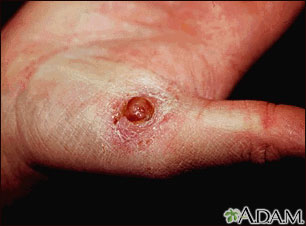Health Library
Pyogenic granuloma
Lobular capillary hemangioma
Pyogenic granulomas are small, raised, and red bumps on the skin. The bumps have a smooth surface and may be moist. They bleed easily because of the high number of blood vessels at the site. It is a benign (noncancerous) growth.
Images


I Would Like to Learn About:
Causes
The exact cause of pyogenic granulomas is unknown. They often appear following an injury on the hands, arms, or face.
Pyogenic granulomas are common in children and pregnant women.
Symptoms
Signs of a pyogenic granuloma are:
- A small red lump on the skin that bleeds easily
- Often found at the site of a recent injury
- Usually seen on hands, arms, and face, but they may develop in the mouth (most often in pregnant women)
Exams and Tests
Your health care provider will do a physical exam to diagnose this condition.
You may also need a skin biopsy to confirm the diagnosis and rule out skin cancer.
Treatment
Small pyogenic granulomas may go away without treatment. If needed, bumps are treated with:
- Surgical shaving or excision
- Electrocautery (heat)
- Freezing
- A laser
- Creams applied to the skin (may not be as effective as surgery)
Outlook (Prognosis)
Most pyogenic granulomas can be removed. A scar may remain after treatment. There is a high chance that the problem will come back if the whole lesion is not removed or destroyed during treatment.
Possible Complications
These problems may occur:
- Bleeding from the lesion
- Return of the condition after treatment
When to Contact a Medical Professional
Contact your provider if you have a skin bump that bleeds easily or that changes appearance.
References
Dinulos JGH. Vascular tumors and malformations. In: Dinulos JGH, ed. Habif's Clinical Dermatology. 7th ed. Philadelphia, PA: Elsevier; 2021:chap 23.
Patterson JW. Vascular tumors. In: Patterson JW, ed. Weedon's Skin Pathology. 5th ed. Philadelphia, PA: Elsevier Limited; 2021:chap 39.
BACK TO TOPReview Date: 11/30/2022
Reviewed By: Ramin Fathi, MD, FAAD, Director, Phoenix Surgical Dermatology Group, Phoenix, AZ. Also reviewed by David C. Dugdale, MD, Medical Director, Brenda Conaway, Editorial Director, and the A.D.A.M. Editorial team.
 | A.D.A.M., Inc. is accredited by URAC, for Health Content Provider (www.urac.org). URAC's accreditation program is an independent audit to verify that A.D.A.M. follows rigorous standards of quality and accountability. A.D.A.M. is among the first to achieve this important distinction for online health information and services. Learn more about A.D.A.M.'s editorial policy, editorial process and privacy policy. A.D.A.M. is also a founding member of Hi-Ethics. This site complies with the HONcode standard for trustworthy health information: verify here. |
The information provided herein should not be used during any medical emergency or for the diagnosis or treatment of any medical condition. A licensed medical professional should be consulted for diagnosis and treatment of any and all medical conditions. Links to other sites are provided for information only -- they do not constitute endorsements of those other sites. No warranty of any kind, either expressed or implied, is made as to the accuracy, reliability, timeliness, or correctness of any translations made by a third-party service of the information provided herein into any other language. © 1997- 2024 A.D.A.M., a business unit of Ebix, Inc. Any duplication or distribution of the information contained herein is strictly prohibited.
